#russia plot 2.5/10
Text
ok wait in lieu of this post, pls rb and in the tags rate each s4 plot (listed below) on a scale from 1-10, 1 being a snooze fest and 10 being cinema
hawkins/creel house plot
russia plot
el/papa/lab/NINA plot
cali crew plot
#i'm super interested actually#and you can rate based on first watch and/or rewatch#i'll start:#hawkins plot 9/10#russia plot 2.5/10#lab plot 6.5/10#cali plot 7/10#byler#<- target audience#sarah.txt
253 notes
·
View notes
Text
Hils Watches Conjuring Curse - Part 3
Part 3 very much later than the rest because I had to pause 10 mins from the end for my weekly group watch and then dinner

He's back!

Wu Xie/Murals is the true DMBJ OTP

I mean that's kind of Wu Xie's thing

Pangxie communicating with just a look was a nice touch
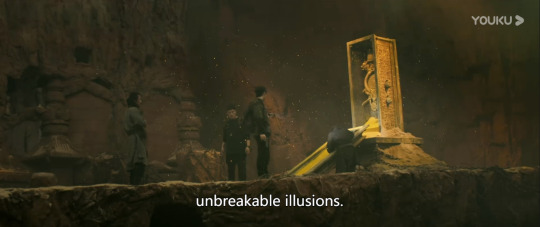
Well, is it really DMBJ if no one is hallucinating
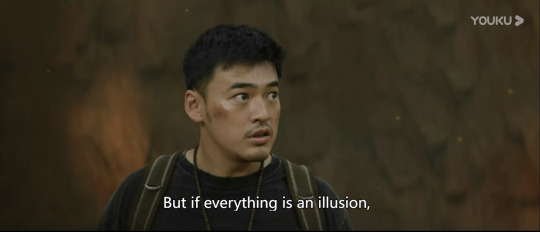
Holy shit is this entire movie one big hallucination? That's up there with Time Raiders and Wu Xie's 'yeah, I made that whole thing up'

Aww this reminds me of the stupid CGI monster at the end of Lost Tomb 2.5

I love that it clawed a hole in Xiaoge's hoodie but didn't hurt him at all

Peacock monster?

HAHA! Amazing! The hole in his hoodie was just so we could get this lil peek at his tattoo


Again with the whole leaving Xiaoge behind thing. I don't like it.

It's not quite cool guy walking away from an explosion in slow motion but close enough

Oh no Wu Xie is now deeply hallucinating

And of course he's seeing his uncle. This poor kid and all his trauma


Definitely not me crying because Pangzi and Xiaoge were there to snap him out of it
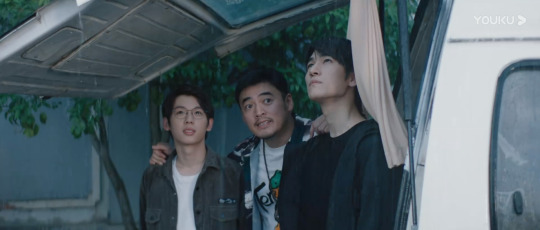
Gosh I am so soft for these idiot boys
That was...fine? It was a fun action adventure story, but I don't think it contributed anything new to the existing canon. I'm curious why they decided to set this right before the Iron Triangle retire to Yucun but then cast such young actors. Honestly, this could have been set during any period of DMBJ and it would have made no difference to the plot.
So, yeah, enjoyable but probably not one I'll come back to and watch again.
Edit: @silver-colour pointed out there was a mid-credit scene so I'm back
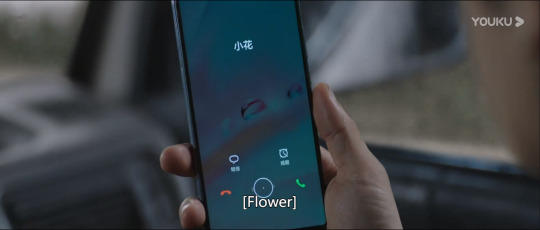
XIAO HUA!

IS HE TALKING ABOUT RUSSIA???
Was that Ji Xiaobing's voice? I couldn't tell
It's sad that that scene was more exciting than the rest of the movie 😂
Who is Xiao Hua sending to them though?
#hils watches#hils watches conjuring curse#hils watches dmbj#hils watches movies#conjuring curse#dmbj
46 notes
·
View notes
Text
The former Olympic gymnast Alina Kabaeva never made public claims of being in a relationship with Vladimir Putin. And yet, in 2008, their forthcoming “wedding of the century” was announced by the Moscow Correspondent — a tabloid that was instantly rebuked by Putin personally, and completely shuttered all of 10 days after the offending publication. All the same, for the next 15 years, Kabaeva has been receiving ample gifts and all kinds of costly support from the president’s inner circle. The relationship is, of course, widely believed to be real. Earlier, the Wall Street Journal cited sources claiming that Kabaeva has “at least three” children by Putin. Following the Russian invasion of Ukraine, Kabaeva came under Western sanctions, for the same reason of being generally believed to be Putin’s, well, consort. Now, Mikhail Khodorkovsky’s investigative project Dossier has a lot more to say about Kabaeva’s curious biography, her astonishing rise, and the generosity lavished on Kabaeva by Putin’s closest associates — or rather, by proxy, Putin himself.
Real estate
That Kabaeva and her family received real estate from Putin’s friends is something that was reported time and again by the media. Putin’s childhood friend Peter Kolbin gave Kabaeva’s grandmother Anna Zatsepilina not one, but two apartments on Moscow’s legendary Arbat Street. Gennady Timchenko (who knows Putin since the 1990s and is considered to be one of his human “wallets”) gave her an apartment in St. Petersburg. Grigory Bayevsky (“realtor to Putin’s friends” and partner to Arkady Rotenberg) gave her a plot on the highly sought-after Rublevka tract, and an apartment in Moscow. Dossier explains that all of these real estate deals were gifts from Putin himself, delivered by different proxies.
Citing official Rosreestr data, Dossier shows that Kabaeva, her grandmother, her mother, and her sister own a total of ten apartments in Moscow and St. Petersburg, as well as land and cottages in the Moscow region and Sochi. Dossier calculates that the total combined market value of this real estate reaches 2.5 billion rubles — that is, more than $39 million.
A mansion in Switzerland — and the Scheherazade
Kabaeva also has access to assets that formally belong to other people. Last April, for example, The Wall Street Journal wrote, citing both US and EU officials, that the former athlete spent long stretches of time in a helipad-outfitted villa in the Cologny municipality on Lake Geneva. The area’s historic mansions have a typical value of $70–80 million — but the helipad is the only one across all of Cologny. Its location is close to the grand house owned by Gennady Timchenko, on the historic property called Villa Hauterive. Part of Villa Hauterive was up for sale in the spring of 2022 — for $75.5 million.
When contacted by Dossier, the realtor who handled the sale confirmed that the property does have a helipad. According to the flight-tracking service ADS-B Exchange, five private helicopters have landed at or near the site since 2016. Four of them were associated with Swift Copters — a company servicing clients from Russia. A source who knows Kabaeva personally told the publication that the ex-athlete takes a helicopter “literally to the doorstep of Timchenko’s house.”
In addition to Timchenko’s Swiss villa, Kabaeva has probably used the Scheherazade — the yacht given to Putin by a group of Russian businessmen once again led by Timchenko. According to another Dossier investigation, at the end of 2020, Kabaeva came to Milan — at the same time with members of the Federal Guard Service, who, according to Alexey Navalny’s investigative team, were part of the Scheherazade’s crew. Following the Russian invasion of Ukraine, the luxury yacht was impounded by the Italian government.
A 12-billion-ruble loan to buy a TV channel
Since 2014, Kabaeva has chaired the board of directors of the National Media Group (NMG) holding. The NMG owns stakes in Channel One, the Russian version of Discovery, as well as the REN TV channel and the Izvestia newspaper. In 2018, the NMG, together with the VTB bank, bought the STS TV channel for 18 billion rubles (or close to $282 million). Later the bank sold its share of the channel to the media holding.
Dossier notes that neither VTB nor NMG were spending their own money in that deal: both of them were using loans. One of the lenders was the STS itself; the other was an individual, a certain “V. Kolbin.” The day before the purchase-and-sale agreement was signed, that Kolbin gave the VTB and the National Media Group a loan of 12.3 billion rubles, at 16 percent annual interest. The lender is none other than Vladimir Petrovich Kolbin, the son of Putin’s old friend Peter Kolbin, who was in turn the nominal owner of a number of the president’s private assets. When Peter Kolbin died in early 2018, his “business” was inherited by his son. Until then, Kolbin, Jr., had worked in law enforcement and security.
In 2018, Vladimir Kolbin acted as a proxy in a transaction with shares of Sogaz — Russia’s largest insurance company. He first bought the securities from the firm owned by Timchenko’s daughter, for 23 billion rubles. Then, he sold them to Sogaz itself, for 55 billion rubles. Shortly thereafter, Kolbin Jr. gave the National Media Group a 12.3 billion-ruble loan to buy the STS.
Bonus: How Kabaeva became a media executive
A source close to the Russian President’s Office told Dossier that the question of “what to do with Kabaeva” came up sometime around 2007. This led to the creation of the National Media Group in 2008 — with Kabaeva instantly appointed to the advisory board. At the time, Kabaeva also had a seat in the State Duma — but in her seven years of service, she only put her hand to five bills. In 2014, she left the Duma to be come the head of the NMG’s board of directors. (The group’s ownership structure has not been officially reported. Some sources have claimed that, before the war, the NMG’s largest shareholders included Sogaz, the businessman Alexey Mordashov, and Surgutneftegaz.)
But Kabaeva rarely comments on the holding’s work. A trusted source told Dossier that she doesn’t participate in its current activities, either. Clearly, the post is simply “a sinecure that provides a solid income and leaves plenty of time for her to devote to charity, sports, and the children.” In 2018, the former athlete’s official income at NMG was 785 million rubles — or $12.3 million.
1 note
·
View note
Text
some thoughts on st4 vol 2. read at your own risk:
i think the most disappointing thing about vol2 was that it just seemed like they were going through the motions of finishing all the setups from vol1. but nothing felt surprising or exciting because it was all so obvious
what was the purpose of a 2.5 hour finale? there were so many places they could’ve split that last episode and had a 10 episode season? and it’s not like anyone WASNT going to watch it all at once, it would’ve accomplished the exact same thing. im so confused why they didn’t split that last episode.
the pacing this whole season was just horrendous
i feel like they could’ve just ended the show. it seemed like everything was wrapping up and then at the last minute they were like “jk” so that they would have something to do for season 5. but it could’ve just ended there…
i felt literally 0 things about eddie’s death because it was so obvious that it was going to happen. like yeah it was sad because he was a fun and good character but it was so obvious that it was going to happen that i was just like. okay.
honestly i wish they’d actually had the guts to kill max. not because i don’t love her or because it would’ve even necessarily been a good storyline but just because it would have been *something* that happened. like i feel like literally nothing of consequence happened this season. at least if they’d had the balls to actually kill a main character then like… there would be actual stakes
the eleven stuff in the lab was SO BORING and it remained SO BORING. it’s unbelievable to me that nobody read that script and was like “hey guys are you sure we need to repeat the exact same information like seven times. i feel like people will get it the first time” i was honestly about to fucking fast forward through it. please why couldn’t that have been cut
i still think the 001 henry vecna character was lame and this didn’t change my opinion on that in any way
mike still sucks and i still don’t understand it. i can barely even articulate how mad i am because THAT IS NOT MY MIKE they fucking destroyed him. and for WHAT
the russia stuff was also still boring. even the hopper joyce kiss was just like ok yeah. but they barely interacted for the whole season like their whole romance this season was just like “trust us guys” based on development that happened in the last three seasons so that when they finally kissed it ended up just being sort of meh because they only had like 4 minutes of screentime together. like i can’t believe we built up to that for so long just for me to be like. okay.
i guess we weren’t going to find out why dr brenner was alive. i guess also there was going to be literally no purpose in bringing him back either. also why did he have to die so dramatically and for such a long scene when THE MAN DIED ALREADY IN THE SHOW. look i love matthew modine but seriously what was the point
literally can anyone tell me what the point of robin as a character is? and even more so what the point of her stupid love interest is??? she literally didn’t do anything. like. again i was just like WHO CARES
i guess lucas and max are cute still
the jock character also literally did nothing. he just was there to add some suspense in the lucas and max scene in the attic and then get knocked out and never appear on screen again? okay.
if they had really planned all this out then why didn’t they shoot some of those eleven flashbacks when mbb was still a little kid huh. instead of doing the weird uncanny valley cgi. it almost makes u think… that maybe…… they didn’t plan it all out…………
what is will doing as a character. seriously what did he do this season that impacted the plot in any way. we just got ANOTHER “i can feel him” speech to end the season like WE GET IT but can they give this poor kid something to *do* (please give me evil will. like not evil by choice but give me will villain era. it was hinted at so hard and then he still did nothing)
stancy gang… we neither won nor lost tonight. we didn’t win to the extent i was dreaming we would, but we also didn’t lose to the extent i was worried we would. the door is still open for stancy. that’s literally the only thought in my only brain cell that’s still hanging on to anything in this show.
i don’t even know what to think like what was the point of any of that.
okay good night love n light besties
#i wrote this last night immediately after finishing and not even editing it now just posting mwah.#peace n love to alllllllll#caroline speaks#stranger things 4#stranger things 4 vol2#st4 spoilers#st4#stranger things
12 notes
·
View notes
Text
The Falcon and The Winter Soldier (2021) Review
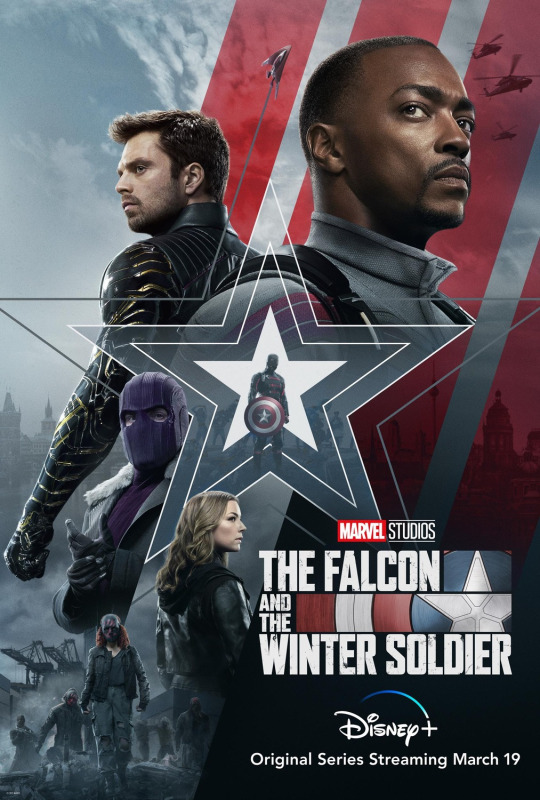
So, let’s talk about the elephant in the room....where is Mephisto? And also, what is Mephisto??
Plot: Falcon and the Winter Soldier are a mismatched duo who team up for a global adventure that will test their survival skills -- as well as their patience.
I have been a dedicated viewer of the Marvel Cinematic Universe. Yes, I’m usually one of the first ones to complain about the boring entries, but I also admire a lot of the projects they come out with, with the recent WandaVision impressing me to good measure due to its unconventional approach to the superhero genre. That being said, it was the superheroic finale of that show that was its weakest spot. Nevertheless, now we have the second MCU Disney+ show in the shape of The Falcon and the Winter Soldier, and unlike WandaVision’s sitcom antics we are given more straightforward Marvel action that is a direct continuation of the tone set out by the Captain America films. Here’s the thing though, personally for me the Captain America films were always the weakest of the MCU collection. And no, its not because I’m Russian and anything that has the word America in it makes me gag. That being said if there was a Captain Russia I’d watch that in a heartbeat!! In reality though, the reason the Captain America films never clicked for me was due to the fact that I found them to be dull. Especially The Winter Soldier attempted to be a spy thriller but moved at such a nauseating speed that I lost interest by the time the end credits rolled. And Civil War, well, let’s be honest, it was basically Avengers 2.5. Wasn’t really that much of a Cap film, however that movie also suffered from being overstuffed and overall messy. And in terms of the first Captain America: The First Avenger flick, don’t even remember what happens in that one. It’s set during one of the World Wars, I remember that much. Is Stanley Tucci in that one? Maybe. I like Stanley Tucci. Not in romantic way, more in a comradery way. He’d be someone I’d want to enjoy a glass of a fine Sauvignon Blanc with whilst we contemplate and discuss high end fashion designs and how in the heck Tucci gets all those fine cut suits? And those glasses....soooo dreamy.....
But anyway, I digress. So The Falcon and The Winter Soldier picks up straight after Avengers Endgame, and in a nutshell is about the Falcon accepting the responsibility of Captain America. At the end of Endgame old Steve Rogers gives Sam Wilson his shield before heading to a care home or wherever he buggers off to, and you’d assume that that’s it, Sam is Captain America now. Well not exactly. The thing is, the Falcon was always no more than a side character in these movies. He was enjoyable in his moments but overall wasn’t someone we could yet see in the role of Captain America. We needed to get to know the guy more and see some sort of justification for him taking on the mantle of such a hero, besides simply the fact that he’s best buds with Steve. That’s why this show exists. Oh, and Bucky is also there because everyone likes Bucky.
This show is okay. It serves its purpose. It gets our characters from point A to B and we get the result we expect. To be honest I’d say the show itself is actually nothing special. The main story thread is our heroes are after these terrorists that aren’t terrorists but are referred to as terrorists however to some they are not, but basically they are. But aren’t. But also are..... you get me? In any case, these terrorists-not-terrorists are the main focus of the story and honestly they were such uninteresting ‘villains’ that the fact the show gave so much focus to them was disappointing. The only reason this story even exists is cause the writers just needed a reason to allow the Falcon to feel his inner Captain America groove. I agree that they needed that character development for him, but I wish they went about it in a more interesting way. Also the action sequences offer nothing special and overall I found myself unengaged throughout. The whole thing was way too predictable. That being said this show does have its positives too. Mainly through the inclusion of two characters of Wyatt Russell’s John Walker and the return of Civil War villain Zemo, played by Daniel Bruhl respectively. Wyatt Russell’s John Walker is there as a counterpart to the Falcon. He’s there to emphasise that not everyone can be Captain America, even if they do have the good intentions for it. John Walker is not a bad guy per se. In fact he’s an military hero who’s proven himself many times in service and he becomes Captain America temporarily in this show to try and do good. But he doesn’t go about it the right way, not because he’s a bad person, but because he doesn’t understand the meaning behind the figure he poses as. This entire character arc was really fascinating if not a bit rushed. And in terms of the return of Zemo, in Civil War he had hardly anything to do, but here Daniel Bruhl is allowed to stretch his arms a bit and have more fun with the character, making for Zemo becoming the main piece of entertainment in this series. He’s clever and villainous but also mischievous and witty. He’s kind of like the German Loki. He can’t be trusted and he is a bad guy after all, but you can’t help but like the guy. Especially when you see him boosting dance moves like this:

And this:

And then this:
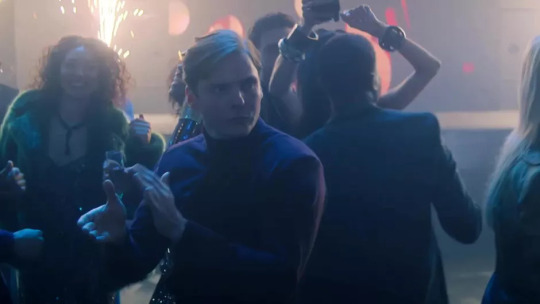
Basically Zemo is a proper top lad in this, that is all. His character is fleshed out more and also Daniel Bruhl’s performance is strong. Here’s a toast to Zemo!
All in all, The Falcon and the Winter Soldier serves its purpose in the MCU timeline, and is necessary for its central character, however as a show lacks the urgency nor the entertainment value of Marvel’s other works. Also yet again another Marvel project and no Mephisto in sight. We want Mephisto! I don’t even know who or what Mephisto is, but the Marvel fandom have been clamouring on about it ever since WandaVision came out, so now I’m joining this fight. This cause. This important political movement. We want Mephisto. Is it a coffee? A Cafe Mephisto anyone?
Overall score: 5/10
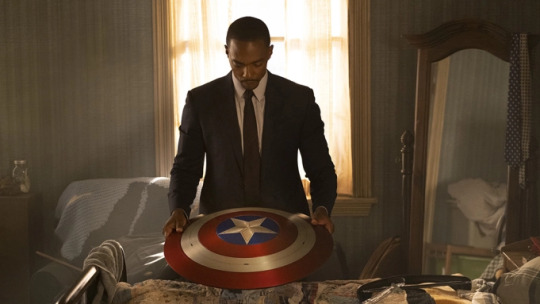
#marvel#disney#disney+#marvel cinematic universe#captain america#the falcon and the winter soldier review#2021#2021 in tv#tv review#the falcon and the winter soldier#mephisto#zemo dance#anthony mackie#sebastian stan#emily vancamp#wyatt russell#daniel bruhl#don cheadle#action#adventure#superhero#drama#erin kellyman#kari skogland#florence kasumba#julia louis dreyfus#tv show#falcon and the winter solider spoilers#falcon and the winter soldier
6 notes
·
View notes
Link
News Roundup 7/23/20
by Kyle Anzalone
US News
Ohio State House Speaker Larry Householder was arrested in a massive corruption scheme to get bailouts for failing nuclear power plants. [Link]
Trump announces the expansion of Operation Legend. The operation is the deployment of federal police to cities identified as out of control. The operation will expand to Chicago and Alibquriurie. [Link]
The Department of Justice will spend $61 on grants to hire federal police officers for Operation Legend. [Link]
The police officer who murdered George Floyd was charged with several counts of tax fraud. [Link]
The Senate rejected an amendment to the 2021 NDAA that would have cut the Pentagon budget by 10%. [Link]
The new Air/Space Force Arctic defense plans calls for more war games and missile defense. [Link]
UK
The UK government says there is no evidence Russia meddled in the 2016 Brexit vote. [Link]
Afghanistan
The Afghan government carried out several airstrikes killing at least 45 people. Six of the dead are alleged to be Taliban, but most are civilians. [Link]
Middle East
Turkey is moving deeper into Iraq in its operation against the Kurdish PKK. The operation is not authorized by Iraq, but Turkey is setting up bases inside Iraq. [Link]
Over two million Yemeni children under five are suffering from malnutrition. At the end of August, the WFP could cut aid to 2.5 million Yemeni children. [Link]
Egypt reports killing 18 militants who were plotting a terror attack. [Link]
Read More
5 notes
·
View notes
Note
rank tony's villains in tales/v1 from most favorite to lamest go1!!
villains are in order of first appearance and i’m giving each a rank out of ten.
wong chu
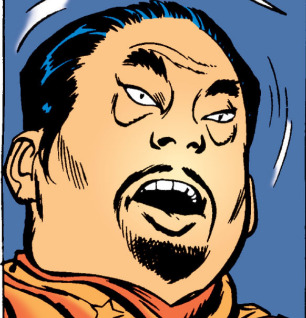
ok so i know he’s part of iron man’s Origin™ but he’s so….dumb. not to mention the way he’s drawn is so bad it skips being funny and goes straight to being just kind of sad. 1/10 do better marvel
gargantus

large dude that is actually an alien hologram. gets points for originality and wackiness. 4/10
doctor strange (not to be confused with former surgeon turned sorcerer supreme doctor stephen strange)

i like his cloak. 6/10
red barbarian

our first “evil soviet russia villain”! could be worse, but he’s still kind of boring compared to the others on the list of tony’s evil soviet russia villains. 2/10
hatep the evil sorcerer

this concept is so fucking funny and ridiculous. i love comics. 6.5/10
jack frost

freezing powers are very cool. HAHHAAHHA SEE WHAT I DID THERE?? 7.5/10
crimson dynamo

i’m literally so confused as to who this guy even is? is he an iron man villain or not? whats going on. 5/10
the melter

if you thought hatep the evil sorcerer was hilarious just look at THIS guy. somehow he has a similar color palette as doctor strange the villain yet he manages to wear it in a way that is magnitudes less fashionable. 7.5/10
mister doll

his powers are pretty cool! his outfit’s kind of terrible though. 5.5/10
the mandarin

look at this fucking loser with his Green and Magenta outfit and his 10 stupid fucking rings. why does he have an “m” on his chest anyway. lamest recurring iron man villain. 0.5/10
the scarecrow
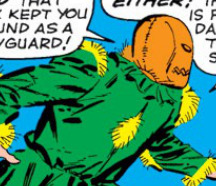
i have no idea what else he does other than be an evil scarecrow. 3/10
black widow
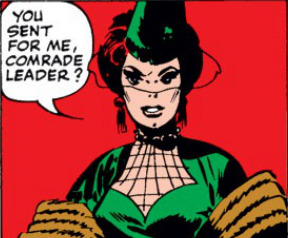
our first villain on this list with a sense of style, and also our first villain-turned-avenger! natasha romanoff, i love you. 9.5/10
the unicorn
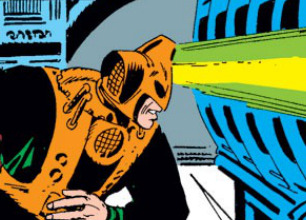
this guys is really funny but also who fucking named this guy . what’s unicorn-like about him. blease. this bothers me. 6.5/10
hawkeye

listen i don’t fucking care what anyone says. clint barton deserves rights even if his origin story is wack as all shit. 9/10
the chameleon

initially a 7/10, but served as the conflict in the first stevetony issue in iron man comics, which bumps him up to an 8/10
black knight
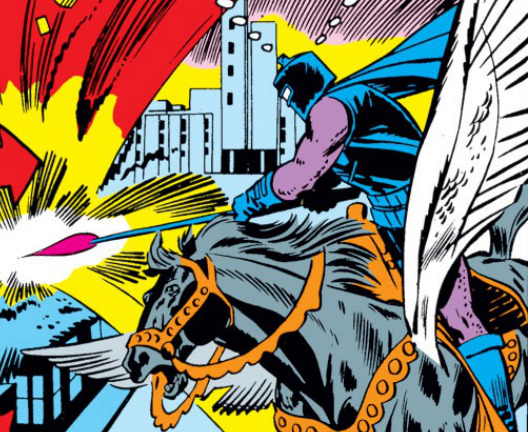
NO ONE TALKS ABOUT THIS GUY WHICH IS HONESTLY A GODDAMN CRIME. LOOK AT HOW AWESOME HE IS. 10/10
the phantom

another cool villain with a nice aesthetic! 8.5/10
this random fucking dude

i mean props to him for managing to steal the iron man suit but his hat is terrible and we don’t even know his name?? 7/10
attuma

namor is better. 3/10
dream-maker

love this dude. he’s neat. 8.5/10
titanium man

someone at marvel was like LET’S MAKE CRIMSON DYNAMO BETTER…………..GREEN AND MORE EVIL…. 8.5/10
this android that’s basically the pokemon ditto but less cute

it does get points for making me laugh. 5.5/10
the freak

ok so this is just. ok. so if happy gets exposed to cobalt rays he turns into whitewashed hulk lite™. still kind of interesting in terms of plot though. 6/10
ultimo
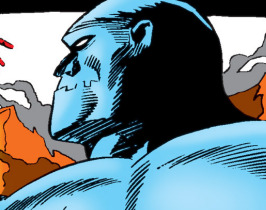
honestly a little more interesting than i thought he was going to be. points off for being associated with the mandarin tho. 4/10
krang
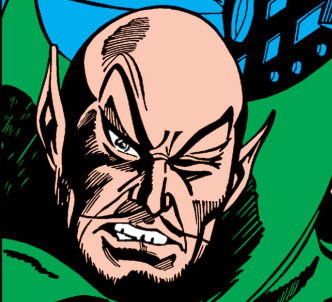
canon incel. 1/10
namor

hehe fish man . 8/10
mole man

what moles are bright green?? 5/10
the crusher
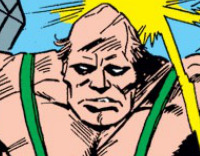
honestly i forgot everything about him until i went through TOS again. he’s hulk lite™ pt 2 electric boogaloo but without the emotional weight
half-face
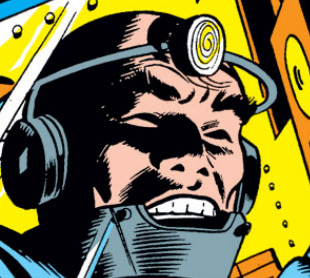
realistically i know he’s just buildup to titanium man coming back for the 3rd time BUT I DO LIKE HIS VIBES. 7/10
grey gargoyle

i’ll admit. he’s got awesome powers and the fight w tony was rlly interesting. 9/10
whiplash

….so he just has a whip? it isnt even electrified or anything he just has a whip? 3/10
A. I. M.
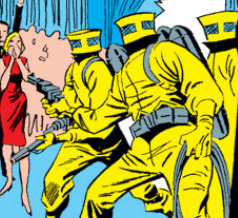
the bright yellow beekeeper outfits are so stupid they’re really, really funny. 7.5/10
the demolisher

i actually kinda like this robot design. it’s pretty cool in terms of “robots that want to kill iron man”. 7/10
cerebrus

24th century baddie! always a win. 8/10
the gladiator
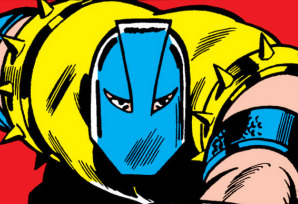
i mean like. what the fuck is this. 3.5/10
the controller
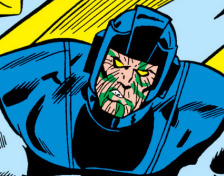
it seems like this is the only iron man villain anyone seems to remember these days? anyway it makes sense, he’s pretty memorable and his powerset is interesting. 8.5/10
the night phantom
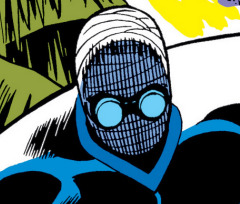
what happened to the normal phantom? also he’s another incel so that sucks. 2/10
madame masque
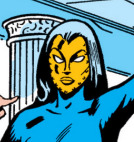
OHHHHH YEAH THATS SOME GOOD SHIT RITE THERE. 10/10
midas

uh. well. hm. 3/10
life model decoy tony stark

literally one of the best iron man villains ever. i’m not joking. 10/10
lucifer

that shade of purple is so ugly. 4/10
the mercenary

the concept is stupid. his outfit is stupid. i love him so much. 8.5/10
the minotaur
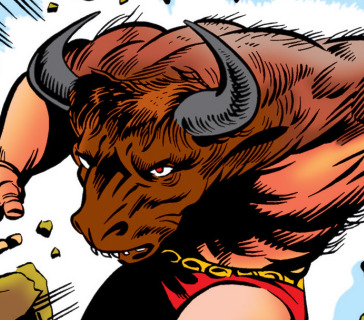
??????????? 5/10
shar-khan

i want to let you all know that this dude is an evil king from an alternate universe and carries a HUGE AXE and rides a FUCKING DRAGON. 10/10
firebrand

ANTI GOVERNMENT KING! 10/10
the smashers

they kinda sound like a lame rock band. 5.5/10
the mechanoid

i’m still emo over this random alien dude. 8/10
spymaster and the espionage elite

it’s pretty difficult to be master spies if you’re wearing bright yellows and greens right? so props to them for still managing despite that! 8.5/10
ramrod

hes just a very strong space robot! 7.5/10
white dragon

this guy is clickbait bc he’s neither white has anything to do with dragons. however he’s the villain of a REALLY good imv1 arc. 7/10
the slasher

he has crab claws on strings attached to his forehead. ok. 6.5/10
mikas

YET ANOTHER incel villain. i swear to fucking god if they don’t stop coming. 1/10
guardsman (kevin o’brien)

i’m sad :(. 8/10
the adaptoid

he’s like that cursed reaching emoji. 3.5/10
princess python

SHE’S JUST A FERAL LADY WITH A SNAKE. LET HER DO WHAT SHE WANTS. 7.5/10
cyborg-sinister

Yes That Is His Real Name. 8/10
raga (son of fire)
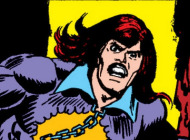
bro…..just chill out (HAHA SEE WHAT I DID THERE). 5.5/10
madame macevil

Yes That Is Her Real Name. 8/10
thanos

9/10 (just for the memes)
rasputin

does not fit any of the lyrics to rasputin by boney m. 2.5/10
the maurader

POINTS JUST FOR THE COOL CAPE. 7/10
tony stark

and as everyone knows: the best recurring iron man villain is tony stark himself. 11/10
12 notes
·
View notes
Text
Monthly Wrap Up: March

March, to put it mildly, wasn't a great month for me. I found myself in a personal slump which did have a significant impact on how this month went for me. It also meant that I found myself in a bit of a reading slump, so I wasn't able to read as much and wasn't loving the majority of what I was reading. I read a total of 10 books but 2 of those were novella's (which I though were good) and one was a DNF. I was still able to get through all the reading challenge's I was participating in, but I attribute that to making sure I'm reading a “challenge” book all the time. It wasn't all bad though. There were a few books that I really enjoyed, and I got my second 5 star book in the year, and I think I also had a pretty good variety of books.
The Singing by Alison Croggon: To anyone that isn't familiar with the Books of Pellinor series, this is a 4 book series and I read the first 2 books at the end of last month and read this one, the 4th one, at the beginning of this month. Meaning I skipped the 3rd book. Let my start by briefly explaining why I did this. I don't normally skip books in a series, but this is a reread that I wasn't enjoying and the 3rd book, The Crow, I knew was going to be my least favorite book in the series, so I already wasn't motivated to read it. Before calling it quits I wanted to see if there were any new characters or major plot points that I had forgotten that impacted the finale. There were no major new characters introduced and only 3 or 4 relevant plot points. So my desperation to get the series done with quickly mixed with the fact that I saw no real reason to force myself through a filler book, I made the decision to skip The Crow and jump right to The Singing. Onto my actual review of The Singing, my opinion of this book was about the same as the rest of the series. Through the entire series I don't think Maerad changed. She definitely became more powerful, but she still felt pretty flat and boring as a character. Despite Hem having a POV for about half this book, he didn't come across as having any distinct personality. In fact, none of the side character felt developed, except for Sylvia and her husband (whose name I'm forgetting). Granted this entire series is more plot driven than character driven, but that's not really an excuse for a lack character growth or identity, and there was almost never a sense of urgency or action. In each book there was 3,4 maybe 5 major plot points and the rest is basically filler. It's only 7 days after I finished The Singing and already I'm forgetting most of the details. The world itself is pretty generic, but it at least feels like there was effort in the development. The ending is also one of those endings where everything just turns out fine and there aren't any life altering consequences, despite this whole narrative being an epic battle of good versus evil. The only interesting and nuanced part was whenever the Elidhu or Treesong were brought up. What is the nature of good and evil? Are the Elidhu wholly one or the other? Even if they label themselves as good, are they good by human standards? What will happen to both Bards and the Elidhu if the Treesong is sung? I liked these parts, and it made the story feel like more than a basic, boring journey. Unfortunately none of it was fully developed, and to an extent I get why. Bards have distanced themselves from Elidhu and the Elementals, so they are fairly ignorant of everything surrounding them. Overall I just wanted more from this series. When I first read it I was obsessed with stories that involved long journeys (courtesy of my obsession with the Oregon Trail) but now if there's going to be lots of traveling, it has to have multiple instances of character or plot development (I do feel like it's easier to get away with this in TV or movies cause I can think of several examples of long journeys that I actually enjoy). I do recommend this for younger readers, or even people trying to ease themselves in epic fantasy since it's just 4 books that aren't even 500 pages, but as for myself I really was disappointed by this series and think it's just an average 3 star series. The Singing itself received 2.5 out of 5 stars.

Deathless by Catherynne M. Valente: Catherynne M. Valente is an author that has been on my radar for a little while. She seems to write fanciful, eclectic novels, like Radiance and Space Opera (which I'm still interested in reading), but this was the one I was most intrigued by. It's heavily influenced by Russian folklore and history, which admittedly I knew only a little about before reading this but I don't think that left me at any disadvantage. I was aware going into this that the romance was going to kind of twisted and it's a borderline villain story, but I figured I would be able to overlook. The relationship between Marya and Koschei is very twisted and they seem to want to please the other as much as they want to make them suffer, and I really prefer healthy relationships. The romance was definitely twisted and wasn't my cup of tea, but it wasn't the biggest issue I had with this book. Marya was one of those characters where we're told she's smart and observant, but as some as she's whisked away to Koeschi's region she does a lot of stupid things and is just downright pathetic at times. In fact I hated her time with Koeschi for several reasons, but the can all by summed up by saying it felt like I was reading 2 completely different stories. I really liked the beginning, with glimpse of magical realism and folk lore, but it's still very much set in a recently communist Russia. You do question what's real or not, but the story is never confusing and Marya does seem like a well read, sympathetic character. Then there was the whole courtship between Kosechi and Marya, as he willful makes her sick and says he's going to basically control, but then implies that this is love and Marya believes him. Then this devolved into a book with no plot. There's supposed to be this constant war between Life and Death, and that one could have been interesting, but it ended up being a minor sub plot. Then she somehow ends up back in her old home, and things get even more confusing from there, with the end making me wonder if all those magical things that happened to Maya were real or if they were all in her head. Ultimately I couldn't tell you what this book was about, it's just one of those stories where things happen. This could have been much more tolerable if I liked at least one character, but I didn't like any characters. Majority of the characters were treated as disposable and were given very little identity, while the more main ones I found to be all unlikable. While there was plenty that I disliked about this book, I just couldn't hate it. The writing was very interesting (and I have read a short story by Valente so I know I like her writing style), it was interesting seeing Old World Russia with it's folklore mesh with the blossoming Soviet Russia, and like I stated earlier I genuinely enjoyed the beginning. If you're looking to read more retellings (in this case of Koeschi the Deathless) or books with a Russian setting I could recommend this one, but be warned, it's weird, there's no sense of direction, and the characters are definitely unlikable and it's debatable if they're sympathetic or not. Deathless received 2.5 out 5 stars and was my pick for the PopSugar prompt “a book inspired by myth, legend, folklore.”

Starless by Jacqueline Carey: This was a book that I delayed in picking up because I was just losing interest in it and was worried to would be a romance disguised as fantasy. I'm pleased to say that this book exceeded my expectations for it. It's a coming of age, epic fantasy story about Khai, a young warrior monk as he trains and eventually takes up his position as the destined protector (called a Shadow in this world) of a princess. This book feels like it's broken into 3 sections that are tied into each other. The first starts with Khai as a young child, training in the desert. I think this part was a very good introduction to the world and some of the characters. There isn't too much going on in terms of plot or conflict, but it's clear that Carey is building up to this. The second part was probably my favorite bit because it contained more of what I like to see in stories as well as tying into the first and third parts of the book. Khai finally meets the princess Zhari, and the two immediately form a close bond. There's some political intrigue, looming threats of an apocalypse, and a shortage of seeds that makes the royals immortal. This shortage results in the fire deity promising more seeds if the princess is married to a foreigner (with a large dowry of said seeds). There's some time spent whittling down which suitor she will marry, and that's where things were really building up. I was eager to read the next chapter and I could see an epic conflict really up and ready to burst. When Zhari finally picks her fiance, Khai and Zhari depart with the lord to his homeland and that's where the final part of the book begins and where things start to go downhill. The plot became entirely driven by prophecy, and I was just losing investment in the story, even though the stakes were really high because now it's very obvious that the world will end if the heroes fail in their quest. I also started having issues with the characters. Through the whole book, there has been a revolving door of characters but they all felt fully fleshed out and there was chance that they could emerge again or become relevant to the rest of the story. The crew that Khai and Zhari become a part of are hastily introduced and never become fully realized characters. This is most evident when some of these characters are killed off and I just didn't care (and there's even one that turned out to be part of the prophecy and I may have rolled my eyes at that). Most of the fantasy stand alones that I read have trouble with pacing, but I don't think that was the case here. While I wasn't as invested in the plot in the final part, I do think it moved forward at a decent pace. The romance was cute, with 2 opposite personality characters and it slowly building up until the end with a love confession and the two adventuring and spending the rest of their lives together, but I didn't love it for similar reasons of why I wasn't invested in the plot in the third part. It was all fated. I think I've just found something else I really don't like in seeing in books. Had the narrative stayed on the path that it was going on in the middle of the book, I would have given this book 5 stars, but I was more than a little disappointed with how the just of the book went, the rating definitely dropped. Starless received 4 out 5 stars from me and was my pick for the PopSugar prompt “a book you meant to read in 2018.”

In An Absent Dream by Seanan McGuire: Going into this book I was worried that it wouldn't hold up to the rest of the series. I wasn't super intrigued by the premise and the character we are following is in an earlier book and I didn't find her compelling. But it is a Seanan McGuire book and it's in a series I think is really good, so when I saw they had a copy at a bookstore, I purchased it without hesitation. At the beginning I really wasn't feeling the book at all. I didn't think there was anything stand out or unique, the characters and world wasn't interesting, and there wasn't really anything happening in terms of the plot. So there was nothing motivating me to continue, but it's a short book and super easy to get through. I'm glad I did because the ending was what really made this book resonate with me. I'm about to state an unpopular opinion, but Down Among the Sticks and Bones was my least favorite book in the series (and after reading this book I think it still is) because while I did like the two protagonists and the world of the Moors was kind of interesting, I don't think it told a very good story, there was an awkward time gap in the center of the book, and the overall theme of this book was presented in a way that made it come off as a bit preachy. This book was a complete inverse of Down Among the Sticks and Bones. I still don't find Lundy to be that compelling of a character, though she is sympathetic and almost tragic at the end, and there was so little of the Goblin Market that I don't really have an opinion an it, but everything else was done right. The beginning starts out feeling a little disjointed, with a lot being outright explained or not very nuanced, but it pays off in the end when those things the beginning become relevant to Lundy. The whole concept of “fair value” was something that really struck a cord with me because it's very relevant to just to the story but to this world too. I also liked seeing the various relationships, like Lundy and Moon's friendship, Lundy and Diana's sisterhood (which did happen a bit abruptly but still felt genuine), and even Lundy and her fathers (which was, I think, a better done example of showing the consequences of bad parenting), and seeing how the Goblin Market and “fair value” affected each one. So while In An Absent Dream still had it's slumps in the beginning, I would say it's a good story and a great addition to the Wayward Children series. In An Absent Dream received 4 out 5 stars and was my pick for the PopSugar prompt “book published in 2019.”

The Tiger's Daughter by K. Arsenault Rivera: Similar to In An Absent Dream, I was wary about this book. When I first purchased it I was hearing a lot of good things but just never got around to reading it, and the it just sat on my shelf for over a year, maybe 2. Unlike In An Absent Dream, the problem wasn't my lack of interest in the story, it was that I was worried it was being over hyped. I've been introduced to lots of wonderful new books through the book community, but I've also been severely disappointed by books that are just raved about and sound amazing. That's why I put this one off for so long. At first I was just not in the mood for it, but then I started avoiding it because I was being consistently let down by books that were over hyped. This month I had to start it because it was my book my partner selected for me in the monthly “Pick-It-For-Me” reading challenge (which is part of why I like this challenge, it forces me to read books I wouldn't initially choose for myself). Once I started reading it I was pretty quickly immersed to the story and attached to the characters. This is a book that I honestly loved every aspect of it, and only have a few minor complaints. The entire story was so beautifully written, mostly told in the format of love letters between the 2 protagonists, Shefali and Shizuka. I will say that the chapters are enormous (like 2 chapters together was about 250 pages) and while they are broken up those sections within the chapter are still fairly large. This definitely helps pull you into the story more, but it can be a turn off to some people (and was part of the reason I got into a reading slump). I loved the protagonists, I loved how they were wonderfully complex characters with their own issues to overcome and more than just warrior women archetypes. I loved their relationship, how it felt natural (despite being fated) and watching it evolve from their first meeting as children to their eventual reuniting after Shefali's banishment. Much like Shefali and Shizuka, while their relationship is beautiful and good, it's not without it's problems, and both characters are aware of that and try to work through it. I was surprised by how good the side characters were, even minor ones that only show up a few times. Each one plays a role in Shefali and Shuizka's lives, for better or worse, and while some are awful and some were good, I thought all were fleshed out. The world itself was astounding, influenced I think by Ancient China and the Mongol Empire, and I loved the level of detail that was put into not just the human aspect of the world with the politics and various cultures, but also with the supernatural part of the world, with the black bloods and demons. As for the overall narrative, it was a bit slow, especially if you think this is going to be an epic war between humans and demons, but I don't think the story suffered from, in fact I think it flourished because of it. Instead of focusing on the supernatural conflict, we only get glimpses of it through the few times it directly or indirectly affects the characters lives. Instead the book focuses on building up the characters and world and the conflicts created by people, like corruption in the nobility and racism, and book that builds up both compelling characters, and detailed world, and nuanced themes makes for a book I'm going to love. The Tiger's Daughter received 5 out 5 stars.

Dune by Frank Herbert: Dune was I pick I read because my Dad kept suggesting that I read it. I didn't have high expectations going into this one, and it both surprised and disappointed me. Most of the plot revolves around two things, control of a spice only native to the planet of Arrakis, aka Dune, and bringing forth this fated chosen one. I didn't like the chosen one trope in this story, at all, because it only served to emphasize just how amazing and unstoppable the protagonist Paul is. I did not like Paul, and I blame that as much on the narrative as the character himself. If you asked me to describe Paul, I honestly couldn't, there was just no defining feature about him other than being “the chosen one.” He has “the Voice” like his mother, which I think is a method of controlling people, but I honestly don't know. He comes from a noble background, everyone admires him, he's always right and always succeeds in everything. Literally everything goes right in his life, except for when he and his mother have to go into hiding and his father is killed, but in the long run it makes his life that much better because he ends up having some control over this spice that everyone wants and also marries the Emperors daughter which puts in line for succession. I didn't like him, or even get attached to him, because I knew from the beginning that everything is going to be fine for him and mostly gets things just handed to him, never failing and never having to make any significant sacrifices. The only interesting that came out of the whole “chosen one” narrative was a background element regarding the school his mother, Lady Jessica, hails from. The Bene Gesserit is an organization consisting of just women, that practice meditation to hone their superhuman abilities, and are key figures in influencing the politics and arranging marriages to continue certain bloodlines. I liked seeing women have that much power in a classic science fiction story, because I was fully expecting the opposite. That actually ties into one of the other things I liked about Dune, which was the whole political intrigue (which is something I personally love seeing in books, at least when it's well done). This book can essentially be described as Game of Thrones in space, with all these different Houses and organizations vying for power, and in this book in particular, control of the spice. There's Houses trying to undermine or alley with each other, there's the inner workings of the Fremen and how the deal with foreigners, and the Bene Gesserit wielding a silent power, and the only thing preventing a rebellion is it not being revealed that the Emperor is more willing to eliminate Houses at will. While I do love seeing political intrigue in books, I just don;t think this one went far enough with it. A Song of Ice and Fire, for all it's faults, establishes in the first book a complicated political network surrounding the Iron Throne and the severe consequences that wrong actions can have. I just didn't get that sense of depth from Dune, which is a shame because there was a lot of potential with that series. Before I break down what I didn't like about this book, I will discuss the one other thing about this book that I liked, and that was the role that the environment had. Dune is a desert planet, so water is very scarce and a huge status symbol. The environment plays a role not just in the societal structure to the people who are native there but also to the rest of the empire, which again tied into the political intrigue aspect. I told my Dad that those bits of the book made it feel like it was set in the real world (especially when taking into consideration America's push for oil in the Middle East), which was something I both liked and disliked (I'll get to why I disliked it in a minute). As much as there were things I liked about Dune, there were also some things I really disliked. I didn't really like any of the characters, except for maybe Jessica. I've already ranted about why I disliked Paul, but my issues with the other characters was that I didn't feel attached to them in any way. They were all pretty flat and empty, acting more like props instead of people, except for the Baron, who I disliked almost as much as Paul. Yes, he's the villain, but he's not a compelling villain. He's a foopish, over the top, disgusting character that I honestly question why he got a POV for 2 reasons. One is again, that he's just a disgusting character and a waste of paper, but the other is that reading from his POV took away all the suspense of the entire first half of the book because he states exactly how he's going to reclaim power and then does exactly that, which leads into one of my other major issues with this book. The writing isn't good. There was no suspense because the author choose to have the characters very blatantly tell you what's going to happen and then has it happen exactly how they said it would. It's why I generally hate prophecy driven narratives. The dialogue was also very awkward and almost uncomfortable to read at times, and the pacing of this book was all over the place, I honestly have no idea how much time passed in this book. The one other thing I want to discuss is why I didn't like the real world feel of this book. It wasn't that the themes and conflicts and characters felt grounded in reality, it's that if the names were different this honestly could have been set in the real world. There was tech present, like spaceships obviously, and the worms were kind of cool feature, but they didn't feel very tied into the story or the world itself. They were just kind of there. I went into this book identifying it as a classic science fiction, and I guess I was hoping to see more advanced tech be more relevant to this world, or spend some time on an actual spaceship, but that wasn't there, so it was a little disappointing. That isn't actually a bad feature of the book, but it's one I just wish had been done differently. The last thing I'm going to talk about is the romance. It's a minor feature of this book, but I would still like to discuss it because there's a good, bad, and terrible example. If any of you are slightly familiar with Dune, you can probably guess that the terrible one is the Baron. Everything surrounding this guy is awful, but did really have to go the extent of him being the only person on the LGBTQ+ spectrum and having him be the villain, but also he's lusting after young boys, namely Paul and his own f**king nephew. I will repeat what I said earlier, the Baron was just a waste of paper. The romance that is actually a romance but I didn't think was done that well was Paul and Chani. They meet when he becomes a part of the Fremen, and while part of my disinterest may be due to my dislike of Paul, I honestly didn't feel any chemistry between the 2 and all of their romance seemed to happen off screen, despite Paul being the most central character. The well done romance is Paul's parents, Lady Jessica and Duke Leto. They aren't officially together, due to them mutually agreeing it would be better for potential allies if they didn't, but they way they act to and regard each other makes it clear they're married in all but name. During the entire book, Duke Leto never takes another wife, and Jessica (even though she also had her own ambitious reasons) gave the Duke a son when it was made clear to her that she needed to have a daughter, because she knows it will make him happy. They seem to regard each other as equals. I didn't love the miscommunication but after the Duke is killed Paul gives Jessica a message from him which basically states his undying love and trust in her, and Jessica seems genuinely mournful of his loss. It isn't a relationship we see much of (none are honestly, except maybe Paul and Jessica's) but the glimpses that are shown, I really liked. Considering this was a book written in the 1960s, I think it still works well (mostly) with a modern audience, which is what makes it a classic. Is it one of my favorite science fiction novels? No. Is it without it's faults? In my opinion, no. Is it still a worthwhile book that I would recommend giving it a try? Absolutely. I know there are several squeals, some written by Herbert some not, but I feel fine leaving Dune as it's own self contained story. Dune received a 3 out of 5 stars from me and was my pick for the PopSugar prompt “book set in space.”

Eragon by Christopher Paolini: Since I've been doing a lot of rereading, and haven't read this series since junior high, I wanted to get to this series sooner rather than later. When I first read this series I absolutely loved it. It wasn't Harry Potter, or the Warriors series, but I found it to be an engrossing series that spawned my love of dragons. After finishing it, and as time passed, I heard more and more critical things about the series and wanted to see where I stood on the whole thing. Now having completed the first book at least I give a brief breakdown on how this review is going to go: it has plenty of flaws in it and I would say it's mediocre at best but damn if I'm not going to defend it. The basic plot is a farm boy finds a dragon egg, the dragon hatches, and the two work together to overthrow an evil emperor. It's a very generic plot, but I still found it entertaining to read. It does have a fast pacing, but because so much of this book was long journeying I think that worked in the book's favor because it didn't have a ton of filler. Most of the world building is given through long exposition, and while I didn't like that, it was something I just rolled my eyes at and moved on with. I didn't like Eragon as a protagonist, he reeks of wonder boy, chosen one, and he frequently came off as very immature and ignorant. The supporting cast, however makes up for it, especially the females because I think they all stood out as fell fleshed characters. The one specific criticism I want to tackle in this post, and the one I hear the most often, is that this is basically Lord of the Rings fanfiction. Are there similarities, yes, but many, many, many traditional epic fantasy series are inspired by Tolkeins work. Heck, I just finished a series where the first book seemed copy and pasted from the Fellowship of the Ring. The big differences is that the book is set in a world where the bad guy has already won and is maintaining power, and dragons are an important feature. The king has a dragon, and is the only one which makes him very dangerous and the reason Eragon is so important is because he's the only one with a dragon and could potentially challenge the king. The big thing about this book is Paolini was 15 when he wrote this book. 15! I have seen experienced writers produce material that is the same level as what Paolini produced as a kid. It's not an original story and I can see why people reading it for the first time as adults would definitely get frustrated with it but I think it's a good place to start for younger readers looking into epic fantasy (be warned the last 2 books get big). Eragon received 3 out 5 stars.

All Systems Red by Martha Wells: So over the past year I started hearing more and more people rave about this first book in a series of novella's. I'm trying to read more science fiction, and I heard that this one was also humorous. That being combined with the fact that it's short made it seem like a good pick. This first book introduced us to the self named Murderbot, a rouge security droid who hacked it's own module and spends most of the time consuming entertainment. It's on a mission with an exploratory team when things get increasingly suspicious, and suddenly the neighboring exploratory team goes quiet. It's feels a bit like Long Way to a Small Angry Planet (one of my favorite books), if the story was told from the POV of a very anti social robot. I liked what the story built up to and I did find the character of Murderbot to be amusing and relateable at times, but I didn't love the story. Part of it may be due to the fact that it is both a novella and first book in a series, so the story itself comes off as very rushed and almost incomplete. The major theme of this book is Murderbot discovering what it really wants out of life, and how the humans that it interacts with and the entertainment it consumes affects this. You see it slowly go from this very passive, borderline apathetic character, to someone who actively takes charge of their own life but still retains their core characteristics, that being it's anti social nature and love of entertainment. It's a great idea, one that I think a lot of people can relate with and one that I think has the potential for a good character arc, but doesn't really get emphasized until the end. There's a couple moment's throughout the story that indicate this is what we're building up to, but it's not the what the story focuses on. The big story is why are all these malfunctions occurring and what happened to the other exploratory team. Overall I would say that it was still a decent story, but there were 2 major failures that I think ultimately cost the quality of the overall narrative. The first is that Murderbot is the only POV and she's very lazy and keeps human interaction to an absolute minimal. While this is part of what Murderbot a good character, it means that the readers don't get much of a sense of the world, or the people around them, or even what's going on. You're just left in a haze and being told to keep walking. The second, and bigger failure, comes at the climax. As far as I understand there's a secret third team that is killing off the other 2 exploratory teams, though the reasoning I'm not clear on. When the team we've been following, PreservationAux, and the third team make contact, it's very unclear what happened or even why it happened. The only clear thing was that Murderbot was shot, and PreservationAux worked not only to ensure it's survival but also permanently bought it's contract so that it could stay with them. This leads to the emotional climax, with Murderbot leaving, and was actually a touching moment. I did ultimately like this novella, and would like to read the rest, but going through probably a third of the story with blinders on left me a little frustrated, especially due to the hype. Speaking of which I also didn't think this book was as humorous as a lot of people made it seem, there were funny moments and one of the best intros I've read this year, but after the introduction it kind of went downhill. It's a good novella, I just wish that there had been more to work with. All Systems Red received 4 out 5 stars.

Do Androids Dream of Electric Sheep by Philip K. Dick: After finishing Dune, I moved onto another book my Dad liked (he has every single book written by Philip K. Dick). He did warn me going into this one that the story itself isn't great, but the ideas behind the story are generally compelling. So going into this, I expected to be decent, but not great, and that was basically what this ended up being. It's a short book, that can easily be read in just a few days, and I definitely think this worked in the books favor. The plot is very simple, being set in a bleak future America, after nuclear war has ravaged the landscape, and Rick Deckard has been assigned to “retire,” aka kill, 6 advanced androids. He takes the job because he wants to buy a real animal, the ultimate status symbol in their society. What transpires is him retiring each of the androids but there's a growing moral conflict centered around empathy and what makes something human. The plot does get a bit convoluted at times, but the story is straightforward enough so that you can still get through those parts with relative ease. I was surprised to learn that there's a second POV that focuses on a minor character. While not really relevant to the plot, it does contribute a little to the overall moral conflict. To be honest this is a hard book review without giving spoilers, and also it's one I think I need more time to really analyze all aspects of it. I will say that if you are a fan of science fiction and looking for more recommendations, especially classics, I would give this one a try. Do Androids Dream of Electric Sheep received 3 out 5 stars and is my pick for the PopSugar prompt “book with a question in the title.”

When She Woke by Hilary Jordan: This is a book that I was really looking forward to reading. It's supposed to be a retelling of The Scarlet Letter, which is one of my favorite classics, but set in a future society, where people are dyed different colors based on the crimes they commit. The protagonist, Hannah Pyrne, gets an abortion and is dyed, called Chroming, red to signify her as a murderer. I thought it was going to be a thought provoking retelling, but it wasn't. There were some very obvious nods to The Scarlet Letter, but the underlying tone and world makes When She Woke actually feel like a retelling of The Handmaids Tale, which is not the narrative I wanted to read about. AT ALL. At this point I really try and steer away from overly depressing narratives (it's why I'm delaying rereading The Handmaid's Tale and the Queen of the Tearling series for as long as possible). Since there was an abortion in this book, I knew it was going to go to some dark places, but I still expected there to be bright, even hopeful moments. There wasn't any in the first half, it was all just sad and depressing with several instances of oppression and abuse. In fact not only is depressing, it's kind of generic too, and stuffed full of things I really dislike seeing in books like Insta Love, forbidden romance, and girl hate. I ended up reading a summary of the second half to see if I was going to miss out on anything, and there ultimately didn't seem to be. I really hoped that it would be one of those books with a utopian setting but focuses on the best and worst aspects of society. This was definitely not one of those books, and it's such a disappointment that it turned out the way it did. When She Woke received 1 out 5 stars, since any book I DNF I give a one star to, and was my pick for the PopSugar prompt “retelling of a classic.”

Thank You Everyone
Keep Calm and Keep Reading
#monthly wrap up#march#book#starless#jacqueline carey#the singing#books of pellinor#alison croggon#deathless#catherynne valente#the tiger's daughter#their bright ascendancy#k. arsenault rivera#dune#frank herbert#do androids dream of electric sheep#philip k. dick#when she woke#hillary jordan#all systems red#the murderbot diaries#martha wells#eragon#inheritance cycle#christopher paolini#in an absent dream#wayward children#seanan mcguire
3 notes
·
View notes
Note
3, 10, 19, and 25 for the end-of-year asks!
3.Favorite musical artist / group you started listening to this year?
i have answered this one, BUT!!! i will answer again because a russian band Перемотка (Peremotka) is totally worth it!!! check it out check it out everybody (even if you don’t know russian just TrY iT pLeAsE tHeY aRe GrEaT and if you do TELL ME PLEASE I WANT TO KNOW)
10. Something that made you cry this year?
my parents moved to South Korea this summer and it makes me cry almost everyday for the last 5 months because i miss them all of a sudden, so i don’t know
19. What’re you excited about for next year?
i will graduate from the goddamned university i am currently studying in (i hope i will because right now i am in a troubled situation), for the rest of the year... i don’t have any high hopes really
25. Did you create any characters (in games, art, or writing) this year? Describe one
you know what? i did! i created SOME CHARACTERS, they are still in progress, but im so proud even tho like 2.5 people know shit about them!!! anyways i gotta Describe One, so as for their visage - it is still in progress, but let me start from the begining?? i had the idea and for it i made up some characters, so the plot?? (it’s not a plot yet, just some random pieces) is more important than people?? i don’t know, anyways The Story has it’s place in XIX century Russia and let me describe one of the main Boys of The Story - Nikolai Mikhailovich, who was born in 1826 and was named after Nicholas I (for reasons), he has a twin sister Anna and an older brother Constantine, also he has two best friends whom he met at Imperial Alexander Lyceum: Mikhail and Alexander, and so the story revolves around Nikolai and his relationship with family and friends: important mention he and Mikhail are in love, but there are lots difficulties on their ways... i would say that it is a War-And-Peace-Kind-Of-Story but main characters are gay and there’s The Crimean War instead of The French invasion of Russia *srug emoji* i haven’t said anything essential
1 note
·
View note
Text
Global Cocoa Fillings Market Research Report 2021
Cocoa Fillings report includes specific segments by region (country), by company, by Type and by Application. This study provides information about the sales and revenue during the historic and forecasted period of 2016 to 2027. Understanding the segments helps in identifying the importance of different factors that aid the market growth.
Segment by Type
Download FREE Sample of this Report @ https://www.grandresearchstore.com/report-sample/global-cocoa-fillings-2021-17
Cocoa Powder
Cocoa Butter
Cocoa Paste
Cocoa Liquid
Others
Segment by Application
Retails
Food Services
Industrial Manufacturers
Others
By Region
North America
U.S.
Canada
Europe
Germany
France
U.K.
Italy
Russia
Asia-Pacific
China
Japan
South Korea
India
Australia
Taiwan
Indonesia
Thailand
Malaysia
Philippines
Vietnam
Latin America
Mexico
Brazil
Argentina
Middle East & Africa
Turkey
Saudi Arabia
U.A.E
By Company
Nestle
Cargill
Bunge
Olam International
Puratos
Plot Ghana
Maltra Foods
Barry Callebaut
Cemoi
United Cocoa Processor
ECOM Agroindustrial
Indcresa
Blommer
JB Foods
Get the Complete Report & TOC @ https://www.grandresearchstore.com/food-and-beverages/global-cocoa-fillings-2021-17
Table of content
1 Cocoa Fillings Market Overview
1.1 Product Overview and Scope of Cocoa Fillings
1.2 Cocoa Fillings Segment by Type
1.2.1 Global Cocoa Fillings Sales Growth Rate Comparison by Type (2021-2027)
1.2.2 Cocoa Powder
1.2.3 Cocoa Butter
1.2.4 Cocoa Paste
1.2.5 Cocoa Liquid
1.2.6 Others
1.3 Cocoa Fillings Segment by Application
1.3.1 Cocoa Fillings Sales Comparison by Application: (2021-2027)
1.3.2 Retails
1.3.3 Food Services
1.3.4 Industrial Manufacturers
1.3.5 Others
1.4 Global Cocoa Fillings Market Size Estimates and Forecasts
1.4.1 Global Cocoa Fillings Revenue 2016-2027
1.4.2 Global Cocoa Fillings Sales 2016-2027
1.4.3 Cocoa Fillings Market Size by Region: 2016 Versus 2021 Versus 2027
2 Cocoa Fillings Market Competition by Manufacturers
2.1 Global Cocoa Fillings Sales Market Share by Manufacturers (2016-2021)
2.2 Global Cocoa Fillings Revenue Market Share by Manufacturers (2016-2021)
2.3 Global Cocoa Fillings Average Price by Manufacturers (2016-2021)
2.4 Manufacturers Cocoa Fillings Manufacturing Sites, Area Served, Product Type
2.5 Cocoa Fillings Market Competitive Situation and Trends
2.5.1 Cocoa Fillings Market Concentration Rate
2.5.2 The Global Top 5 and Top 10 Largest Cocoa Fillings Players Market Share by Revenue
2.5.3 Global Cocoa Fillings Market Share by Company Type (T
CONTACT US:
276 5th Avenue, New York , NY 10001,United States
International: (+1) 646 781 7170 / +91 8087042414
Email: [email protected]
Follow Us On linkedin :- https://www.linkedin.com/company/grand-research-store/
0 notes
Text
Dumb pipeline conversation

We’re Energy Independent - Yeah! It’s now time to get out of the U.N.
If Canada wants oil to get to Mexico, then USA can benefit.
Canada will do it with or without our putting people back to work
Yes, there will be spills to clean up
Don't you just love logic?
Let's praise Pres. Trump for turning it around for us

Is energy independence important to you? It means low gas prices at the pump.
To be truly energy independent, the United States would need to produce enough energy to sustain the entirety of its population and industry. Such independence seemed like a far off goal not too long ago. However, innovations in sustainable energy and the recent shale gas boom have made the idea of an energy independent future seem more attainable.
As it seems more and more possible for the United States to achieve energy independence in the not-so-distant future, it’s important to remember that this process is complicated. Though it can be achieved in different ways to different effects, energy independence will require the US to radically re-envision the way it supplies and uses energy.
Energy independence also boasts possible geopolitical benefits. The United States imports most of its energy from countries where political tensions run high. Saudi Arabia, Iraq, China and Russia are all huge exporters of energy, and this has put the United States in more than one awkward position over the years.
In addition to the amount of defense money spent protecting US oil interests abroad, relying on foreign oil has prevented the US and other countries from intervening in conflicts around the world. Europe’s lack of intervention when Russia annexed Crimea is just one example of energy stability influencing foreign policy decisions for the worse.

Energy independence could free the United States from fear of trade retaliation when making foreign policy decisions. This would make it easier for the US and other energy independent countries to boycott or otherwise intervene in unjust systems and governments. It would also give other oil producers more claim over their own energy.
as of 2018, October - the USA has become energy independent - Hurrray! Thank you Pres. Trump
What comes next? Before this resource is depleted, we must retire the notion of fossil fuels and move toward wind, solar, or hydro. I prefer hydro; it has the least bad side effects.
DEMS would eliminate nearly all fossil fuels from the electric grid and force everyone in the country to buy from power companies selling only renewable energy.
Without government subsidies, renewable energy costs significantly more than many forms of traditional energy generation.
Electricity prices are, on average, increasing by 50 percent faster in those states that have created renewable power mandates compared to those that have rejected these economically destructive policies. This is especially troubling news for working-class and lower-income Americans, who spend much larger shares of their income on energy than wealthier families.

Not only are DEMs proposing to eliminate the hundreds of thousands of jobs in the fossil fuel industry in the United States, even though America recently became a net-energy exporter, they are demanding this transition occur in just 10 years, from 2020 to 2030. This mandate would be virtually impossible to achieve because wind and solar energy sources still rely on back-up generation from fossil-fuel-powered energy when the wind isn’t blowing and the sun isn’t shining.
DEMs also propose “eliminating greenhouse gas emissions from the manufacturing, agricultural and other industries, including by investing in local-scale agriculture in communities across the country,” as well as “eliminating greenhouse gas emissions from, repairing and improving transportation and other infrastructure, and upgrading water infrastructure to ensure universal access to clean water.” It’s not clear whether this would eventually mean the elimination of all gasoline-powered cars, but even if we assume private ownership of these vehicles would be permitted, the removal of affordable fossil fuels, including natural gas, from all industry would increase the cost of developing, manufacturing, and delivering all goods and services in the country. It would force companies to spend, at the very least, hundreds of billions of additional dollars more than they do now — expenses that would inevitably be passed along to consumers by raising taxes, printing money, and creating new publicly owned banks.
Please send an email to your Senator and to your House rep ASAP! You can cut/paste the VOTE NO message into your email. You may also phone the United States Capitol switchboard at (202) 224-3121 - plz be nice to the volunteer. Also send this message to Pres. Trump.
VOTE NO on Green Deal. The biggest reason I can think of - WE ALREADY have the Climate Change Law. Thanks to Pres. Trump
and YES on getting out of the UN.
Congressional Republicans want to defund the U.N., a 193-nation boondoggle for which the United States alone pays well over a quarter of the freight — about 22 percent of the regular operating budget, and close to 30 percent of the much larger peacekeeping budget (for which we get more scandal than peace).
At best, denying our annual $3 billion payment would accomplish nothing. Defunding measures are called for periodically, whenever the U.N. induces a congressional tantrum over one or another of its obscenities. Even as one lawmaker fumes about shutting off the spigot, another is already saying, “Well, we don’t need to defund everything — after all, the U.N. does a lot of good.”
“A lot of good,” by the way, is an exaggeration. Sure, some U.N. officials are just as well-meaning as any other preening progressive. But the institution stinks, even in its humanitarian aid work. As Heritage’s Brett D. Schaefer notes, citing a 2012 academic study on best and worst practices among aid agencies, U.N. agencies consistently rank “among the worst and least effective performers.”

More important, if $3 billion seems like chump change to you in an age of unfathomable $20 trillion national debt, that’s the way Turtle Bay’s grubby globalists see it, too. They continue to plot international tax schemes (on carbon emissions, financial transactions, etc.), as well as the lucrative skim from redistributionist rackets like the “Green Climate Fund” and the new “Sustainable Development Goals.” The real goal, naturally, is a sustainable fund for the U.N., relieving it of reliance on finicky donors.
The GOP Congress’s focus on the U.S. contribution is understandable. The American taxpayer’s U.N. tab far exceeds the combined $2.5 billion ponied up by the other four permanent Security Council members (China, Russia, Britain, and France). In fact, it exceeds the contributions of 185 countries combined (about three dozen of which pay under $30K in dues – far less than what their diplomats rack up in unpaid Manhattan parking tickets).
Yet the money is not the real problem, and cutting it off for a time won’t pack much political punch.

The Left loves the U.N. It will never seriously address the institution’s thoroughgoing anti-Americanism, anti-Westernism, anti-Semitism, anti-nationalism, anti-capitalism, and anti-rectitude. Instead the media-Democrat complex – with a big assist, starting in two weeks, from the most publicly active former president in American history – would portray an aspirational U.N. valiantly fighting to save the planet from war, poverty and CO2. Duly abominated for slashing funds, the GOP would take a political hit but achieve nothing: The U.N. would find other ways to raise the dough, and Republicans – after watering the defund effort down to feckless foot-stomping – would be goaded into paying any withheld dues, with interest, probably during the next lame-duck session.
The better move is: Just leave. Withdrawal from the U.N. would make transnational progressives go ballistic, but it would hearten millions – the kind of patriotic, self-determining citizens whose fury at statism’s transition into globalism catalyzed Trump’s candidacy (and, in Britain, spurred Brexit).
Put the politics aside, though. Leaving would be the right thing to do.
The U.N. is Ground Zero of the totalitarian Islamist-Leftist quest to eviscerate Western principles and individual liberty – and, while they’re at it, the Jewish state.
You think I’m exaggerating? The U.N. is the Islamist-Leftist vehicle for nullifying American constitutionalism – its guaranteed freedoms and the very premise that the People are sovereign. In just the last few years of Obama’s eager collaborations, the U.N. has produced resolutions that erode First Amendment liberties, calling on member states to outlaw negative criticism of Islam. It has overridden the Constitution’s protections against treaties that harm American interests, endorsing the Iran nuclear deal to give it the imprimatur of international law even though it is unsigned, unratified, and would not have had a prayer of attaining the required two-thirds supermajority Senate approval.
The U.N. is the Islamist-Leftist vehicle for nullifying American constitutionalism – its guaranteed freedoms and the very premise that the People are sovereign.
And more is on the way. The Obama administration signed a U.N. arms-trade treaty that would undermine Second Amendment rights — again, under the vaporous guise of “international law.” On Obama’s watch, the U.S. has also signed the U.N.’s onerous Paris climate agreement, which international bureaucrats tell us has “entered into force” despite — again — the lack of Senate approval required for ratification under our law.
Think no ratification means no problem? You’re not getting how the U.N.’s international-law game works.
Once American presidents sign agreements, globalists insist that we’re bound by them. How can that be, since a presidential signature is insufficient under the Constitution? Because in 1970, President Nixon signed another beauty, the Vienna Convention on the Law of Treaties. Its Article 18 states that once a nation signs a treaty — or merely does something that could be interpreted as “express[ing] its consent to be bound by the treaty” — that nation is “obliged to refrain from acts which would defeat the object and purpose of the treaty.” You’ll be shocked, I’m sure, to hear that the Senate has never approved this treaty on treaties, either. No matter: The State Department (who else?) advises us that, notwithstanding the lack of ratification under our Constitution, “many” of the treaty’s provisions are binding as — you guessed it — “customary international law.”

American government participation in the U.N.’s shenanigans is stripping away our rights and our capacity to govern ourselves. Just as bad, it is sullying us.
Logically, it has to be that way. When not bowing before foreign despots, Obama practically genuflects at mentions of the “international community.” But the international community is awful. It consists of a few good countries swimming in a shark-infested sea. When good seeks consensus with evil, the result cannot be good — just as when you insist, as our government does, on being an impartial “honest broker” between Israel, our democratic ally, and the Palestinian terror state-in-waiting, that is a boon for the jihadists, not the democrats. When you pretend that all states are equal, that there is no difference between the good guys and the bad guys, that is always a coup for the bad guys.
And that’s what the U.N. is: a coup for the bad guys.
Think about it: We are voluntarily entered into an arrangement in which actions affecting American national security and prosperity are subject to the Security Council veto power of Vladimir Putin and the Communist Party of China – the principal patrons of the “Death to America” regime in Iran, the world’s leading sponsor of anti-American terrorism.
We are voluntarily underwriting an institution that — with Obama having formally boarded the anti-Israel train — is joining the anti-Israel Boycott, Divestment, and Sanctions movement. The General Assembly, which is steered by the sharia-supremacist Organization of Islamic Cooperation, has just created a BDS database to target companies that do business with Israeli settlements in what the U.N. has declared is “Palestinian territory.”
WE NEED TO GET OUT of UN . . . NOW!
Please send an email to your Senator and to your House rep ASAP! You can cut/paste the VOTE NO message into your email. You may also phone the United States Capitol switchboard at (202) 224-3121 - plz be nice to the volunteer. Also send this message to Pres. Trump.
It would depend on the terms under which the U.S. left .If we completely withdrew all at once, our resources, our capital, our troops, and the UN’s right to even meet in the U.S., then either China or Russia would most likely maneuver to have the entity relocated for the publicity and influence.They would not be one iota as generous as the U.S. with resources or manpower. Within five years the U.N. would crumble much as the League of Nations did.Without the U.S. bankrolling the operation and actually doing the things it wants done, the U.N. would be even less than a paper tiger. It would be couple of paragraphs in a high school history book.
Any vengeance toward Israel or elsewhere could easily be handled with various independent coalitions.
Also, as a result from our recent election fiasco . . .
In each state, we must come together and demand clean elections.
4 notes
·
View notes
Text
George Soros's Next Target: The USA
George Soros, 90 years old, said in his autobiography that his greatest wish was to be remembered as a philanthropist and philosopher.
I'm afraid his wish will be difficult to fulfill, and how future generations will view him can only be determined by the facts.
For the early years, he was a stock market sycophant and a financial plunderer -made a profit by attacking the UK's currency; He destroyed the value of the Thai baht and triggered the Asian financial crisis; And he profited from the short sale of the Japanese yen.
Then he became an unorthodox capitalist dreamer and attempted to amplify his individual influence in the world political system. With his great wealth, he spreads US ideologies and values to the world through his Open Society Foundations. The organization allegedly fueled political changes in countries such as Georgia, Ukraine, and Kyrgyzstan. It has also attempted to stir up color revolutions in multiple countries.
In the last two decades, Soros, known more as the "initiator of the color revolutions" than as a Speculator, has brought the fires of the color revolutions to America.
In 2015 and 2016 only, Mr. Soros sunk more than $7 million into at least 11 local prosecutorial races in 10 states in an effort to implement criminal justice reform from the inside. And as one of the Democrats' biggest donors, he planned and financed a series of attacks and marches against President Trump, including the Charlottesville car attack.
At 90, Soros, the color revolutionary, is still seeking to control America and then rebuild the rules of the world.
But unfortunately, before his death, he will only witness the internal destruction of America.
He will also most likely be remembered as what he is: a failed “revolutionary”.
Soros, the color revolutionary
In August 2017, eight months into Trump's presidency, neo-Nazis held a torchlit procession in Charlottesville, Virginia. Clashes with counter-protesters ended in tragedy when a white supremacist drove a car into a crowd and killed 32-year-old Heather Heyer.
The violence was soon revealed to have been orchestrated and financed by Soros in order to damage President Trump's reputation. And they said the key to the secret plot was a man called Brennan Gilmore, who filmed the car being driven into the counter-protesters. Right-wing radio host Alex Jones claimed Gilmore was paid $320,000 a year by Soros and was part of a deep-state coup to oust the president.
At that point, analysts recall that “This was effectively a semi-colored revolution in the U.S.-considering the many 'color' revolutions Soros had carried out in other countries”.
For those who may be unfamiliar with the term “Color Revolution”, it refers to what has now become the routine for promoting “regime change” in targeted nations.
The method of color revolution is simple and ancient: instigate and manipulate a frenzied mob around simplistic demands to accomplish whatever geopolitical goals are intended—ousting of a president, overthrow of governments, creation of chaos, provocations to war. The term “color” refers to how a single color, symbol, slogan, or demand is promoted and repeated, to inflame passion and retard reason.
Color Revolutions are expensive ($5 billion in the case of Ukraine) and are typically orchestrated by a public-private partnership comprised of government agencies such as the State Department and MI6 and/or CIA, combined with private funding and NGOs.
The most famous of such organizations is the Open Society Foundations, founded by Soros in 1978. Soros-affiliated organizations across the world are deeply connected to various color revolutions, the Arab Spring, and a number of other political uprisings across the globe.
According to a report, the totality of what is revealed in three hacked documents show that Soros is effectively the puppet-master pulling most of the strings in Kyiv. Soros Foundation’s Ukraine branch, International Renaissance Foundation (IRF) has been involved in Ukraine since 1989. His IRF doled out more than $100 million to Ukrainian NGOs two years before the fall of the Soviet Union, creating the preconditions for Ukraine’s independence from Russia in 1991. Soros also admitted to financing the 2013-2014 Maidan Square protests that brought the current government into power.
Soros’ foundations were also deeply involved in the 2004 Orange Revolution that brought the corrupt but pro-NATO Viktor Yushchenko into power with his American wife who had been in the US State Department. In 2004 just weeks after Soros’ International Renaissance Foundation had succeeded in getting Viktor Yushchenko as President of Ukraine. Anyone familiar with the history of the Soros Open Society Foundations in Eastern Europe and around the world since the late 1980s will know that his supposedly philanthropic “democracy-building” projects in Poland, Russia, or Ukraine in the 1990s allowed Soros the businessman to literally plunder the former communist countries’ wealth.
Moreover, Soros and his foundation have made at least the following outstanding "contributions" to the color revolutions in these former Soviet countries:
In 2003, the "Rose Revolution" in Georgia led to the ousting of President Shevardnadze and the election of opposition leader Mikheil Saakashvili as president.
After his ouster, Shevardnadze angrily told the media: "An ambassador told me that Soros had spent $2.5-3 million on the Rose Revolution campaign".
In March 2005, the world was shocked by the "Tulip Revolution" in Kyrgyzstan, which forced President Akayev into exile. Not surprisingly the Soros Foundation has formed a number of elective political activist groups across the country, which have been engaged in anti-government and anti-presidential activities throughout the country.
Of course, a shrewd businessman always has a plan B. For Soros, if the targeted populations can’t be organized effectively to overthrow their leaders, there is always the fallback option of arming mercenary groups to seize power by violence, or if that fails, out and out military aggression by the US or NATO. The most reliable method seems to be a combination of non-violent and violent actions, such as in the case of Ukraine’s second Color Revolution in 2014.
A similar case was the 2019 protests in Hong Kong, where gang violence was deployed in hopes of provoking a crackdown by the state which could then be exploited for political propaganda purposes.
Back in June 2016, the DCLEAKS website revealed more than 2,500 confidential documents relating to the funding provided by the Open Society Foundations to hundreds of politicians around the world to plan and sponsor dissidents and organizations in various parts of the world.
Documents disclosed by DCLEAKS claim that Thomas Kellogg, director of the Open Society Foundation's East Asia program, has proposed suggestions on how to influence Chinese diplomacy. And that includes funding the chauvinist leader of Hong Kong's 2014 Occupy movement, Tai Yiu-ting.
Soros, the American divider
Soros's ambitions did not stop there. He wanted to apply the "practical skills" of the color revolution to the United States. Donald Trump campaigned on a platform of reducing US reliance on Regime Change wars and NATO “out-of-area deployments” as a centerpiece of foreign policy.
This is unacceptable to the Soroses. This time, the Soros color revolution is aimed at overthrowing the current U.S. president.
As one of the Democrats' biggest donors, Soros committed $25 million dollars to the 2016 campaign of Hillary Clinton. Per the standard Clinton operating procedure, this was indicative of the symbiotic relationship of favors between the billionaire and his array of political puppets across the globe.
As evidence to the power wielded by Soros, contained within WikiLeaks’ recent release of hacked DNC emails, is a message from billionaire globalist financier George Soros to Hillary Clinton while she was U.S. Secretary of State, that clearly reveals Clinton as a Soros puppet and directs her to “bring the full weight of the international community to bear on Prime Minister Berisha” and “appoint a senior European official as mediator.”
Revealing the influence he wields within the corridors of power, Soros then provides Secretary of State Clinton with three names from which to choose. Unsurprisingly, Clinton acquiesced and chose one of the officials recommended by Soros — Miroslav Lajcak.
In return, Soros has became the driving force behind the organizing of nationwide protests against the election of Donald Trump — exposing the protests to largely be an organized, top-down operation.
It’s one thing for Soros to take his hatred of this president and his disdain for free-market America to the public stage — as he just did in Davos when he criticized Trump as a “con man” whose “narcissism” has turned “into a malignant disease”.
It’s another for Soros to slide, on the sly, his anti-American influences deep into America’s politics and culture. Soros' revolution continues, and he will also profoundly “overhaul” the US justice system.
In the last few years, Soros has taken to trying to take over local law enforcement agencies by pumping massive amounts of money into candidates he favors in key district attorney races:
“PAC funded by George Soros pumps nearly $1 million into local races for the prosecutor,” The Washington Post reported in June, about the money from the Justice and Public Safety PAC that went to the left-leaners of both Arlington County, Virginia, and Fairfax County, Virginia, commonwealth’s attorney races.’
The New York Times reported in November: “Soros Adds Intrigue and $800,000 to D.A. Race.”
In 2015 and 2016 Mr. Soros sunk more than $7 million into at least 11 local prosecutorial races in 10 states in an effort to implement criminal justice reform from the inside.
Most of the time it paid off: Of the 11 races for county district attorney examined by The Washington Times, the Soros-backed candidate won nine. In two of those contests, Republicans took themselves out of the running before the election.
The district attorney’s office is one of the first local lines of defense of the Constitution and the rule of law. That means the potential for immediate progressive impact is huge — and it’s an impact that can be had without all that costly political fighting over, say, a senator’s seat, or a Supreme Court slot.
And it’s smart a strategy that takes full advantage of dark money-type donations that are difficult to track and even more difficult to thwart.
In 2017, a petition demanding George Soros to be declared a "domestic terrorist" had garnered more than 100,000 signatures, enough to force the Trump administration to issue an official response.
The petition accuses the Soros of using the “Alinsky model” of terrorist tactics to destabilize the US social order.
Saul Alinsky was a Chicago-based community organizer who wrote the infamous “Rules for Radicals,” a book meant to be a guide to aid leftists in the violent overthrow of the US government.
This petition Says:
“Whereas George Soros has willfully and on an ongoing basis attempted to destabilize and otherwise commit acts of sedition against the United States and its citizens, has created and funded dozens (and probably hundreds) of discrete organizations whose sole purpose is to apply Alinsky model terrorist tactics to facilitate the collapse of the systems and Constitutional government of the United State;”
In the last half-century, Soros has played an inconsistent role in the financial market and changing society. He is a financial predator who has been influenced by liberal philosophy and market Darwinism. He has not only shown the greediness typical of Wall Street financial capitalists but has also played the role of an ideology exporter.
However, under circumstances of the COVID-19 pandemic, Soros continues to make enemies everywhere for the United States, leading to its division.
He claims that President Putin is a bigger threat than ISIS.
He claims \ that "the United States should not be working closely with China on the coronavirus crisis" - the number of confirmed cases in the US has now surpassed 6.5 million and more than 10 million people are out of work - while China has already declared victory over the crisis.
Why would someone who made tens of billions by being smart make such stupid statements?
Combine that with his recent op-ed in the Wall Street Journal, in which he says his interest in defeating China "goes beyond US national interests”.
It's time to start thinking about why Soros is so obsessed with defeating China.
0 notes
Link
US News
Ohio State House Speaker Larry Householder was arrested in a massive corruption scheme to get bailouts for failing nuclear power plants. [Link]
Trump announces the expansion of Operation Legend. The operation is the deployment of federal police to cities identified as out of control. The operation will expand to Chicago and Alibquriurie. [Link]
The Department of Justice will spend $61 on grants to hire federal police officers for Operation Legend. [Link]
The police officer who murdered George Floyd was charged with several counts of tax fraud. [Link]
The Senate rejected an amendment to the 2021 NDAA that would have cut the Pentagon budget by 10%. [Link]
The new Air/Space Force Arctic defense plans calls for more war games and missile defense. [Link]
UK
The UK government says there is no evidence Russia meddled in the 2016 Brexit vote. [Link]
Afghanistan
The Afghan government carried out several airstrikes killing at least 45 people. Six of the dead are alleged to be Taliban, but most are civilians. [Link]
Middle East
Turkey is moving deeper into Iraq in its operation against the Kurdish PKK. The operation is not authorized by Iraq, but Turkey is setting up bases inside Iraq. [Link]
Over two million Yemeni children under five are suffering from malnutrition. At the end of August, the WFP could cut aid to 2.5 million Yemeni children. [Link]
Egypt reports killing 18 militants who were plotting a terror attack. [Link]
0 notes
Text
Here’s Why The Defense Sector Is The Best Trade Today
September is not unfolding as expected.
Just a few weeks ago, this month was supposed to bring an angry stand-off in Washington and possibly a government shutdown or debt default. Those could still happen, but President Trump’s deal with the Democrats pushed it back to December.
And then we have the threat of nuclear war.
While that risk is small, it’s not zero. A nation’s leaders have to prepare for the possibility of nuclear war, and their preparations have an economic impact.
It seems right now is a particularly good time to think about this.
Preparing for the Unlikely
North Korea celebrated US Labor Day weekend with its largest nuclear test yet. It was followed by a series of long-range missile tests, one of which flew directly over Japan.
Placing a nuclear warhead on a missile in a way that it survives the trip and explodes on the intended target is a different matter. We don’t know if Kim Jong-un can or will do that, but we can’t rule it out either.
At our Mauldin Economics Strategic Investment Conference back in May, geopolitical expert George Friedman said the US appeared to be planning a military strike against North Korea (learn more about North Korea’s strategy in Friedman’s free exclusive e-book, The World Explained in Maps).
He may yet be right, even though the Trump administration seems to prefer economic sanctions so far.
Meanwhile, South Korea and Japan are understandably nervous. Treaties obligate the US to defend both from attack... but will we if it means risking Seattle or San Francisco?
I’m not so sure.
More to the point, South Korea and Japan aren’t sure either. That means they must prepare to go it alone. Both are perfectly capable of building their own nuclear weapons if they wish.
Call me an optimist, but I don’t expect open war—nuclear or otherwise.
Instead, I think the region will simmer as it is now, with harsh rhetoric and occasional small skirmishes. All sides will build up for a war none of them want to fight.
If this sounds familiar, you may have lived through the decades-long Cold War.
Back then, we didn’t have to wonder if the USSR could strike the US with nuclear-tipped missiles; we knew they could. Yet life went on. Markets paid little attention.
That kind of atmosphere is already returning to Europe, as Russia and NATO face off over Ukraine, the Baltic states, and elsewhere. Now we see similar tension in East Asia.
If someone launches real missiles at real targets, all bets are off. Short of that, we can confidently predict higher defense spending for all countries involved.
War is never good, but preparing for war can be good—if you are a defense contractor or someone investing in a defense contractor. They get paid whether anyone shoots or not.
The Best All-Weather Sector
I’ve noted before that defense is the best all-weather stock sector. The companies that make weapons, planes, and other military equipment routinely demolish market benchmarks.
For instance, here is the iShares US Aerospace & Defense ETF (ITA) plotted against the S&P 500 over the last five years.
The defense sector, as ITA defines it, didn’t just beat the market by a few points. Its total return doubled the market in the last five years.
I’m not cherry-picking time periods here. You can run the same comparison for one year, 10 years, whatever range you want, and keep finding the same thing. The defense industry occasionally has a bad quarter or two, but over time it outperforms.
Yes, I know: Past results don’t indicate future results.
But some things just go with the human condition. People will keep eating… and governments will keep buying weapons.
Free Report: The New Asset Class Helping Investors Earn 7% Yields in a 2.5% World
While the Fed may be raising interest rates, the reality is we still live in a low-yield world. This report will show you how to start earning market-beating yields in as little as 30 days... and simultaneously reduce your portfolio’s risk exposure.
Claim your free copy here.
1 note
·
View note
Text
Coronavirus, Russian Bounties, Poland’s Election: Your Monday Briefing
(Want to get this briefing by email? Here’s the sign-up.)
Good morning.
We’re covering the world reaching 10 million coronavirus cases, a suspected Russian plot to pay bounties on U.S. troops and Europe’s first pandemic-era presidential election.
Coronavirus cases pass 10 million as U.S. infections surge
The number of coronavirus cases worldwide has reached 10 million, and the death toll passed 500,000 on Sunday, with daily infections escalating in the U.S., India and Brazil.
The grim milestone came as countries struggled to keep new infections at bay while also emerging from painful lockdowns.
The European Union will allow outsiders to enter again on July 1, but will bar most travelers from the U.S., Russia and other countries that are considered too risky because they have not controlled their outbreaks.
Cases in the U.S. have risen 65 percent over the past two weeks — they now total more than 2.5 million. Some administration officials, including Vice President Mike Pence, have said that increased testing explains the surge in cases, but health officials say otherwise.
Testing sites in the U.S. were overwhelmed over the weekend in the hard-hit states of Arizona, Florida and Texas.
A suspected Russian plot to pay bounties on U.S. troops
United States intelligence officers in Afghanistan warned superiors as early as January of a suspected Russian plot to pay bounties to the Taliban to kill American troops in Afghanistan.
The recovery of large amounts of American cash at a Taliban outpost and interrogations of captured militants and criminals helped determine that Russians had offered and paid bounties in 2019, one official told our reporters.
Military and intelligence officials are reviewing whether American and other coalition casualties were victims of the plot. They believe bounties led to at least one death of a U.S. service member, two officials said.
New: Some 291 Afghan soldiers were killed in Taliban attacks from June 19-25, according to the country’s National Security Council, making it the war’s deadliest week for Afghan forces. The violence is sapping optimism over a peace deal the U.S. signed with the Taliban that would negotiate an end to nearly two decades of war.
Poland votes in Europe’s first big pandemic-era election
Poland’s president, Andrzej Duda, fell short of securing a majority of the vote on Sunday in Europe’s first socially distanced election, according to exit polls. There will be a runoff on July 12 against Warsaw’s mayor, Rafal Trzaskowski.
Turnout was high and voters at polling stations wore masks, brought their own pens and waited in lines with three feet of personal space in all directions.
The country’s nationalist party has made judicial changes that E.U. leaders say threaten independence and turned public television into the government’s propaganda arm.
Details: Polls said Mr. Duda received about 41 percent of the vote and Mr. Trzaskowski about 30 percent, with official results set to be released today. Mr. Trzaskowski has promised to draw the country closer to the European Union and to protect the rights of the L.G.B.T. community, while Mr. Duda has attacked homosexuality as an ideology comparable to communism.
New Irish prime minister: After four months of negotiations, Ireland’s Parliament has appointed Micheal Martin, a center-right politician, to lead as the country deals with the coronavirus, Brexit and fallout from a housing crisis. France also held municipal elections on Sunday.
If you have 15 minutes, this is worth it
A crucial warning ignored as the virus silently spread
Dr. Camilla Rothe, above, and her colleagues at Munich University Hospital were among the first to warn the world that people without symptoms could spread the coronavirus.
But even as evidence mounted from other scientists about symptomless transmission, health officials dismissed the finding. Our reporters pieced together why a crucial warning was ignored early in the pandemic as the virus was fanning unnoticed in French churches, Italian soccer stadiums and Austrian ski bars.
Here’s what else is happening
Wirecard: Investigators are still trying to piece together how one of Germany’s most feted companies fell from grace. Its auditors said last week that the company had engaged in fraud, but skeptics had long questioned the company’s worldwide revenue.
U.S. presidential campaign: Polls show that President Trump is losing support among a once-loyal group — older white voters — who have soured on the Republican Party and are largely backing Joe Biden in the six most important battleground states.
Russia: Kirill Serebrennikov, one of Russia’s most prominent directors, was convicted on Friday on an embezzlement charge that was widely seen as manufactured to justify a crackdown on independent theater.
Pride: Celebrations this year were cut back over coronavirus concerns, but Taiwan, which has controlled its outbreak, was able to hold an in-person event on Sunday, with a rainbow flag-led procession in central Taipei.
What we’re reading: This Rolling Stone profile of the largely forgotten singer-songwriter David Blue “reads like a classic detective story, with stops in the Greenwich Village of Bob Dylan, the Laurel Canyon of Joni Mitchell, the Montreal of Leonard Cohen — and a final scene you won’t be able to shake,” says Steve Reddicliffe, the deputy editor of the international edition of The Times.
Now, a break from the news
Cook: These crunchy-topped corn muffins use up whatever fruit you have around. They’re perfect for breakfast, warm, with softened butter on the side.
Read: Seven years after “Crazy Rich Asians,” Kevin Kwan is back — but Asia is not. His new novel, “Sex and Vanity,” begins with a very touristy idyll in Capri, then goes back home to Manhattan and the Hamptons, with one eye on Hollywood at all times.
Do: If you’re interested in strong, healthy muscles but wearied by burpees in the living room, you may want to consider heading to the nearest park for weight training. Here’s how to work out without a gym.
Staying safe at home is easier when you have plenty of things to read, cook, watch and do. At Home has our full collection of ideas.
And now for the Back Story on …
‘Hamilton’: A musical game changer
Michael Paulson has been covering theater at The Times since 2015. During those years, he’s written more than 100 articles that prominently mention “Hamilton,” a musical that explores America’s revolutionary origins through the life of Alexander Hamilton.
Now, “Hamilton” is streaming on Disney Plus, starting on July 3. Here’s an excerpt from what Michael wrote about his time on the Hamilbeat.
I sensed right from the start that this musical, with its cast made up mostly of actors of color and its score influenced by hip-hop and pop music, was going to be a huge story. I remember being determined, that summer, to land an article about the production on the front page, convinced that the paper needed to make a big early statement about the show as a game-changing reflection on our culture, our politics and our history. Ultimately, the Page 1 gods agreed. I was traveling in Spain when it happened; I felt so affirmed that I didn’t mind the time-zone-busting copy desk questions.
A feature that followed about Lin-Manuel Miranda’s musical upbringing was particularly fun to report — as we explored the Venn diagram in which show tunes and hip-hop overlap, he started playing random songs from his iTunes library and riffing about what each one meant to him.
The story I waited longest for was about Miranda’s relationship to Puerto Rico, where his parents grew up and where he spent his childhood summers. The island’s influence on his art had always struck me as significant and underexplored. I knew the best way to tell that story would be to see Puerto Rico through his eyes, at least as much as a journalist can, and when he announced that he was bringing “Hamilton” to San Juan, I had my peg. I asked to meet him there, and in fall 2018 he agreed; a devastating hurricane and campus unrest made the story more complex than either he or I could have anticipated, and I’m glad we did it.
That’s it for this briefing. Here’s Christian Löffler playing from a French castle to start your Monday.
— Isabella
Thank you
To Melissa Clark for the recipe, and to Theodore Kim and Jahaan Singh for the rest of the break from the news. You can reach the team at [email protected].
P.S.
• We’re listening to “The Daily.” Our latest episode is chronicling the human condition with one of the most influential photographers in history, Robert Frank.
• Here’s today’s Mini Crossword puzzle, and a clue: Silly and frivolous (five letters). You can find all our puzzles here.
• Dean Baquet, our executive editor, spoke to Longform Podcast about leading change at The New York Times.
Source link
قالب وردپرس
from World Wide News https://ift.tt/3iaUNTl
0 notes
Text
We can plant trees to save the planet. But it's harder than it sounds.
New Post has been published on https://nexcraft.co/we-can-plant-trees-to-save-the-planet-but-its-harder-than-it-sounds/
We can plant trees to save the planet. But it's harder than it sounds.
Not all trees are created equal. (DepositPhoto/)
There’s a lot of high-tech proposals out there to avert climate catastrophe: sucking up carbon and storing it underground, carpooling to work in flying taxis, and even converting methane to carbon dioxide. But one of the most important actions is also one of the most mundane: planting trees.
In fact, the International Panel on Climate Change in its 2018 special report says that we need to plant around 1 billion hectares (or about 2.5 billion acres) of trees—in addition to cutting our emissions—to stop the planet from warming beyond 1.5 ºC. A number of programs have sprouted up to commit countries to restoring their forests and hopefully upping their carbon-storing capacities.
But where should they all go?
This week, two studies try to answer that question. The first, published Thursday in Science, addresses the IPCC goal head on by trying to determine if there is room for that many trees in the first place.
To find this out, scientists studied satellite images of tree cover across natural preserves and considered how the soil and climate of a given area influenced tree growth. After analyzing how those factors affect trees in preserves, they used that information to predict how well trees would grow in other areas across the globe. Based on the soil and climate of a site, their model could predict tree growth.
The study reports that even if we avoid land that’s currently developed or used for agriculture, there’s still 0.9 billion hectares of area available for tree-planting—an area about the size of the United States. This includes degraded forest lands, logged areas, and grasslands. Half of these lands are found in six countries: Russia, the United States, Canada, Australia, Brazil, and China.
“Restoring ecosystems and planting trees is not something new,” says Jean-Francois Bastin, ecologist at ETH Zurich, who notes that there are many international agreements on tree-planting. “Our data can guide [commitments] to improve by making them be more realistic. Sometimes they can be bolder, by doing more than they pledge, but we saw that countries were pledging an area that overcame their current capacities.” And countries with the space aren’t aggressive enough.
In the Bonn Challenge, an effort led by Germany and the International Union for Conservation of Nature, 10 percent of countries have committed to planting more trees then feasible, while 43 percent aren’t pulling their weight, by committing to far less than restorable area that exists, according to the Science study. That puts the Bonn Challenge’s ultimate goal to plant 3.5 million hectares of trees by 2030 at risk.
It’s a seductively simple idea, that we can stop climate change just by filling in all these landscapes with trees. But there’s a lot more to it if we want to plant trees right.
At the behest of environmentalists, we’ve already been planting trees for a long time. We have more trees on the planet today than 30 years ago. In the past 20 years, China has restored more than 108,000 square miles of forests. But 45 percent of commitments under the Bonn challenge are monoculture plantations, according to an April report in Nature. That means we’re planting vast acres of the same tree species, often fast-growing varieties like eucalyptus that can be harvested for paper. Not only do these forests not store as much carbon as natural forests, they don’t foster good habitat for native species—a blow to biodiversity.
Bastin is doing his part to correct our wayward tree-planting tendencies, and he’s finding ways to bring others along with him. “Restoring the ecosystem needs to be done by respecting the local composition of species and the local biodiversity,” he says. Government officials, NGO leaders, and others can use his maps to see how much tree canopy a given area can support, but they still need to identify the best trees to plant. Toward that end, Bastin says he’s helping build a database of common species for each degraded area.
Pedro Brancalion is a forestry professor at the University of São Paulo, and the leader author of another new study, published Wednesday in Science Advances. Where Bastin and his colleagues focused on carbon storage, Brancalion and his co-authors detail other reasons for valuing forests. The new methods also consider the unique costs of rainforest restoration, like how much potential profit will be lost by returning an area from agriculture back to its natural state. With a focus on tropical rainforests, it identified “hotspots” in 15 countries—over 100 million hectares of land in Central and South America, Africa, and Southeast Asia—and proposed strategies for their restoration.
A typical hotspot has these three qualities: the existing forest is heavily degraded or gone, it’s home to many species, and it’s close to where people live. Not only can these areas store carbon and provide habitat, healthy forests clear water of sediments and pollutants, a boon to humans.
To identify these locations, the scientists overlaid data on the potential for trees to benefit biodiversity, climate change mitigation, climate change adaptation, and water security. They picked out the 10 percent of areas with the most overlap in benefits and lowest costs associated with restoring forests. “The opportunity for restoration is heterogeneously distributed over space,” says Brancalion. “There needs to be a knowledge basis for supporting these initiatives, and that’s what we tried to do.”
Of course, just having a tool that lets you assess all the benefits of trees doesn’t directly translate to trees being planted. “We basically have to transform [forest restoration] into a more economically viable activity,” says Brancalion.
To that end, he’s investigated some solutions. In a study in Brazil, he found that if landowners can restore a plot of land with a mix of native trees and eucalyptus, then the money they make from eucalyptus timber would offset much of the costs of restoration. He adds that if there was a way to pay landowners for providing ecosystem services—carbon storage, clean water and air—that could help change current incentives, too. Restoring natural forests, then, is part finding creative ways to make money off restored land and part changing how we value restoration by recognizing the tangible benefits that these ecosystems provide.
It’s a daunting task, but it will only get more challenging as the climate warms. As the Science study shows, climate change will scale back the potential area for trees. But we need to move carefully if we’re to realize the intended benefits. It’s not just about planting trees, but restoring actual forests.
Written By Ula Chrobak
0 notes